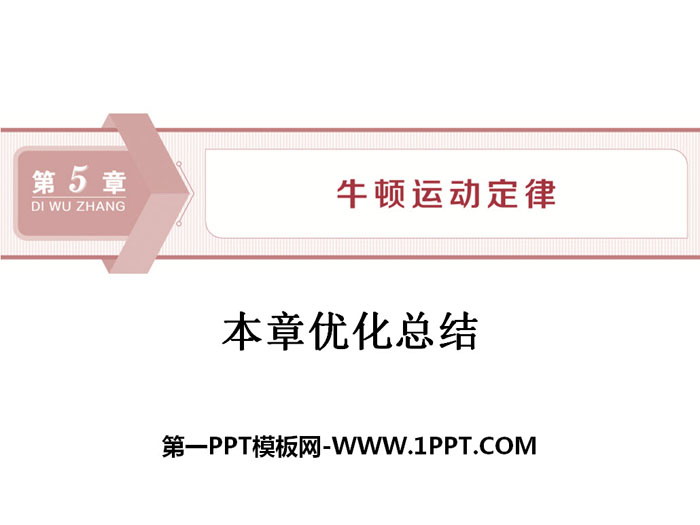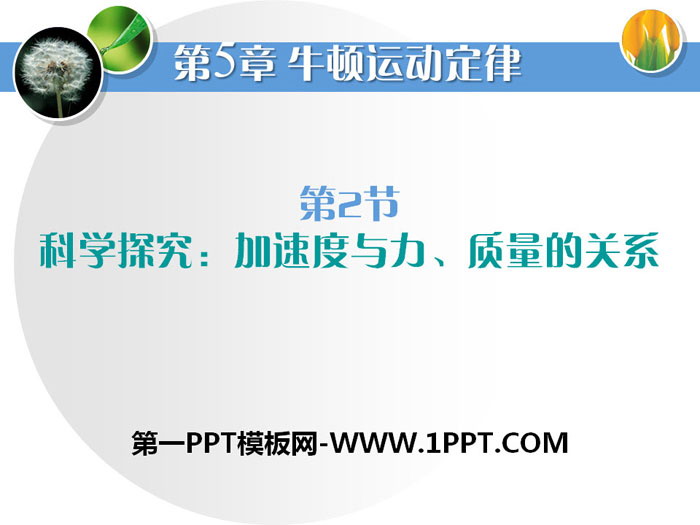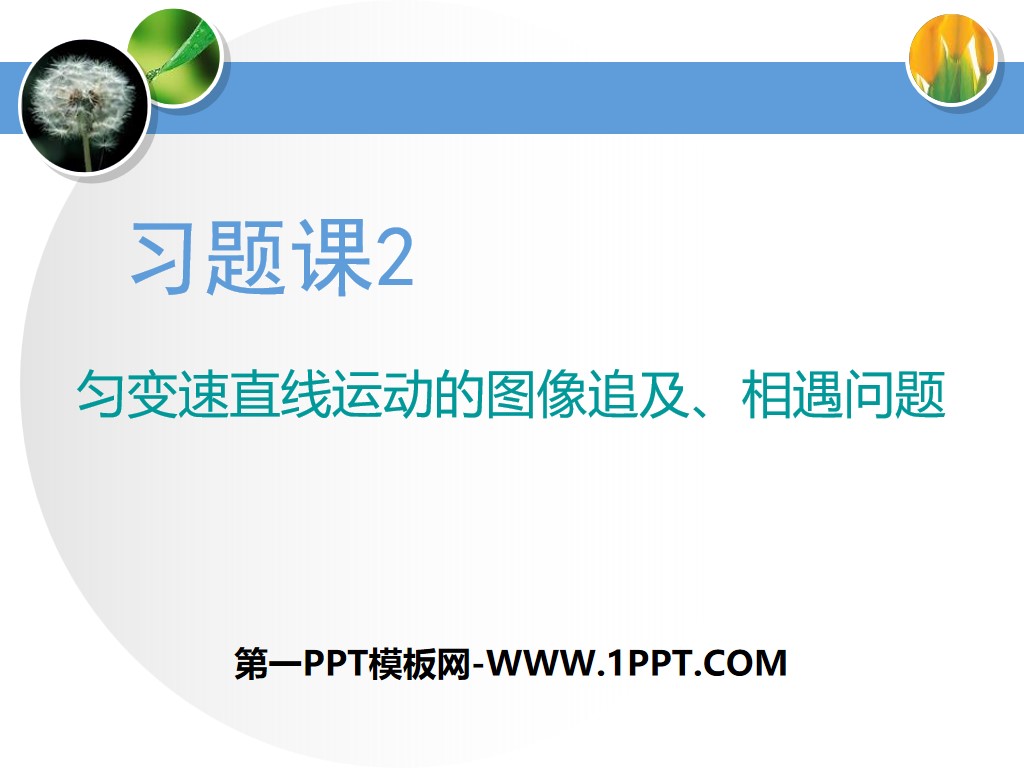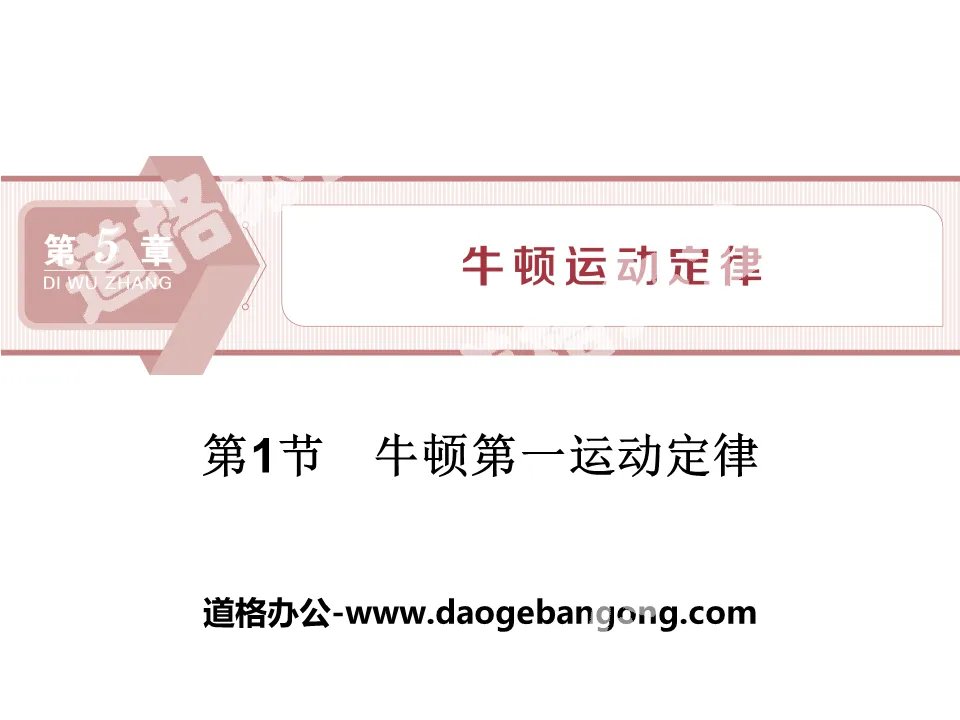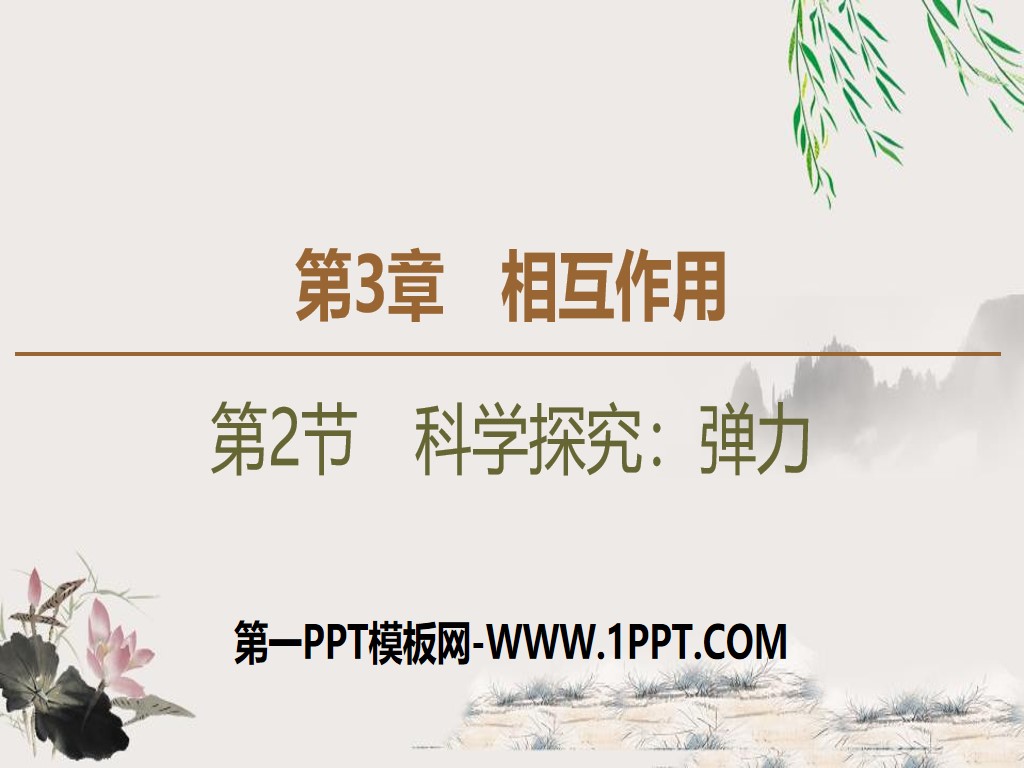
| Category | Format | Size |
|---|---|---|
| Lu Ke Edition High School Physics Compulsory Course One | pptx | 6 MB |
Description
"Scientific Inquiry: Elasticity" Interaction PPT Courseware
The first part of the content: [Learning literacy·clear goals]
Physical concepts: 1. Know the concept of deformation and common deformations. 2. Understand elasticity, elastic deformation, elastic limits and the application of elastic force. 3. Be able to use Hooke's law to calculate the elastic force of springs.
Scientific thinking: Can judge whether there is elastic force between objects based on the conditions under which elastic force is generated or the motion state of the object.
Scientific exploration of elasticity PPT, part 2: independent preview to explore new knowledge
Knowledge sorting
1. Deformation and elasticity
1. Deformation: The changes in shape of an object such as _____, _____, _____ are called deformation.
2. Elastomers and elastic deformation
(1) An elastic body is an object that can return to its original shape after external force is removed.
(2) Elastic deformation refers to the deformation that occurs in _____.
3. Parametric deformation: An object _____ returns to its original shape after deformation. This deformation is called paradigmatic deformation.
4. Elastic limit: When the deformation of an elastic body reaches a certain value, even if the external force is removed, the object will return to its original shape. This value is called the elastic limit.
5. The definition of elastic force: When objects in contact with each other _____, because the object wants to return to its original shape, it will exert a force on the object with which it _____. This force is called elastic force.
6. Direction of elastic force: The direction of elastic force is always _____ with the deformation trend of the object, so that the object can return to its original shape.
2. Hooke’s law
1. Content: Within the elastic limit, the elastic force of an elastic body (such as a spring) is proportional to the length of the elastic body _____ (or _____).
2. Formula: F=_____.
3. Applicable conditions: within _____ of the elastomer.
4. Stiffness coefficient: It is a physical quantity with a unit, and the unit is _____. The physical meaning of the stiffness coefficient of a spring is 1 N/m: the elastic force generated when the spring is extended or shortened by 1 m is 1 N.
Basic self-test
1. Think and judge (mark “√” if correct, “×” if incorrect)
(1) After the external force that causes the object to deform is removed, the object must be able to return to its original state. ( )
(2) As long as two objects are in contact with each other, elastic force must be generated between the two objects. ( )
(3) As long as two objects deform, elastic force must be generated between the two objects. ( )
(4) The magnitude of the elastic force is always proportional to its deformation. ( )
(5) When there is elastic force between two objects, the two objects must be in contact. ( )
(6) From F=kx, we know that k=Fx, so the stiffness coefficient k is directly proportional to the external force F and inversely proportional to the deformation amount x. ( )
2. Regarding elastic deformation, which of the following statements is correct ()
A. The change in the shape of an object is called elastic deformation
B. The deformation of an iron wire after it is bent with force is elastic deformation.
C. The deformation of an object that can return to its original shape after the external force stops acting is called elastic deformation
D. The deformation of an object under the action of external force is called elastic deformation
3. A car is parked on level ground. Which of the following statements is correct ()
A. The ground receives a downward elastic force because the ground elastically deforms; the car does not deform, so the car is not subject to elastic force.
B. The ground receives a downward elastic force because the ground elastically deforms; the car receives an upward elastic force because the car also deforms.
C. The upward elastic force on the car is due to the deformation of the ground; the downward elastic force on the ground is due to the deformation of the car.
D. None of the above statements are correct
Scientific exploration of elasticity PPT, the third part: cooperative exploration to overcome difficult problems
deformation
1. Two cases of deformation
(1) Change of shape: refers to the change in the appearance of an object when force is applied, such as a rubber strip changing from short to long when stretched; during pole vaulting, the pole in the athlete's hand changes from straight to curved, etc.
(2) Volume change: refers to the change in the volume of an object when force is applied. For example, if you press a volleyball hard, the volume of the volleyball becomes smaller; if you press a sponge hard, the volume of the sponge becomes smaller.
2. Methods of displaying tiny deformations
(1) Optical magnification method: As shown in the figure, place two plane mirrors M and N on a large table, let a beam of light be reflected by the two mirrors in turn, and finally hit the wall to form a light point P. Press the tabletop hard At this time, the desktop deformed. Although the deformation was very small, the mirror tilted toward the middle of the desktop. Due to the large distance between the two mirrors, the light spot moved significantly on the wall, showing the deformation of the desktop.
(2) Mechanical amplification method: As shown in the picture, plug the mouth of a round glass bottle with a stopper with a thin tube inserted in the middle. Press the glass bottle gently with your hand. The glass bottle will deform, the volume will decrease, and the water will be squeezed. After rising and releasing your hand, the deformation resumes and the water surface falls back to its original position.
For training
1. (Multiple choices) Among the following situations, which ones belong to elastic deformation ()
A. When a pole vaulter takes off, the pole deforms
B. When you sit on a chair, the seat surface deforms slightly
C. Thin steel wire is wound into a spring
D. Aluminum barrel was smashed
2. As shown in the figure, place two plane mirrors M and N on a large table, let a beam of light be reflected by the two mirrors in turn, and finally hit the wall to form a light point P. Press the table hard and observe the position of the light point on the wall. The change. Which of the following statements is correct ()
A. F increases, P does not move
B. F increases and P moves up
C. F decreases and P moves down
D. F decreases and P moves up
regular method
deformation of objects
(1) All objects can deform, but some are obvious and some are not.
(2) Methods to display micro deformation: optical amplification method, mechanical amplification method, etc.
Elasticity
1. How to judge the presence or absence of elasticity
(1) Method 1: For situations where the deformation is relatively obvious, it can be judged based on the conditions under which the elastic force is generated: ① The objects are in contact with each other; ② Elastic deformation occurs. Both conditions must be met at the same time for elasticity to occur.
(2) Method 2: For situations where the deformation is not obvious, there are usually two methods: ① Hypothesis method: Assume that the object in contact with the research object exerts elastic force on the research object, and see whether the research object can maintain its original state under the hypothetical conditions. If can, indicating that if the assumption is true, the elastic force exists; otherwise, the elastic force does not exist.
As shown in the figure, a ball on a smooth horizontal surface is at rest against a vertical surface. Does the vertical surface exert any force on the ball? Assume that a force is exerted on the ball vertically. From the effect of the force, it can be seen that the ball will not be stationary, so it can be determined that no horizontal elastic force is generated.
②State method (judgment based on the motion state of the object) In the situation shown in the figure, if the AC surface and the AB surface have elastic forces on the ball, and the directions of these two elastic forces are perpendicular to the AC and AB surfaces respectively, then the ball will As shown in the figure, since AB's elastic force F2 facing the ball prevents the ball from remaining still at its original position, which is inconsistent with the actual situation that the ball is at rest, AB's elastic force F2 facing the ball does not exist.
(3) Method three: For situations where the deformation is not obvious, the hypothesis method is usually used to judge.
2. Several common directions of elasticity
3. Calculation of elastic force
(1) Formula method: Calculation using the formula F=kx, suitable for calculation of the elastic force of elastic bodies such as springs.
(2) Balance method: If the object hanging on the vertical string is in a stationary state, when solving the pulling force of the string, two-force balance can be used to obtain that the pulling force is equal to the gravity of the object. Currently, it is mainly applicable to the situation of two-force balance. .
regular method
In the conditions for the generation of elastic force, contact is the premise and extrusion is the key. Whether the objects in contact with each other undergo elastic deformation is a sign of the existence of elastic force. However, in fact, except for the obvious deformation of springs, rubber strips and other objects when elastic force is generated, most When some objects generate elastic force, the deformation is very small and difficult to observe with the naked eye. Therefore, there are two main methods to judge whether there is elastic force: 1. Conditional method; 2. Hypothesis method.
hooke's law
1. The establishment of the law is conditional, which is that the spring must undergo "elastic deformation", that is, within the elastic limit.
2. In the expression, x is the deformation amount of the spring, which is the length of the spring extension (or shortening), not the original length of the spring, nor the length after deformation of the spring.
3. The stiffness coefficient k in the expression reflects the "softness" and "hardness" of the spring, which is determined by the properties of the spring itself (such as material, shape, length, etc.). Different models and specifications of springs have different stiffness coefficients.
4. According to F=kx, draw the relationship between the elastic force F and the deformation amount x. As shown in the figure, this is a straight line passing through the origin, and its slope k=Fx=ΔFΔx.
[Example 3] As shown in the figure, the free end B of a spring faces the zero mark of the scale when no weight is hung, and faces the mark 20 when a 100 N weight is hung.
(1) When the spring is hung with 50 N and 150 N weights respectively, what should be the scale corresponding to the free end?
(2) If the scale facing the free end is 18, how many weights are suspended at the lower end of the spring?
Scientific exploration of elasticity PPT, the fourth part: reaching the standard and solidifying the double base in class
1. The picture is a schematic diagram of the pressure of object P on object Q. The correct one is ()
A - The pressure of object P on object Q should act on object Q, and the direction of the force should be perpendicular to the contact surface and directed towards object Q, so B, C and D are all wrong. ]
2. The shot put is placed on the level ground and is in a stationary state. Which of the following statements about the force on the shot put and the ground is correct ()
A. The downward elastic force on the ground is due to the elastic deformation of the ground; the shot put is hard and does not deform.
B. The downward elastic force on the ground is due to the elastic deformation of the ground; the upward elastic force on the shot put is because the shot ball also deforms.
C. The downward elastic force on the ground is due to the elastic deformation of the shot put; the upward elastic force on the shot put is due to the deformation of the ground.
D. The pressure of the shot put on the ground is the weight of the shot put
C. There is an elastic force between the two objects. They must be in contact with each other and deformed. The downward elastic force on the ground is due to the deformation of the shot ball. The upward elastic force on the shot ball is due to the deformation of the ground. Therefore, A. B is wrong. The pressure of the shot put on the ground is exerted by the ground instead of the shot put. D is wrong. Only option C is correct. ]
3. Two smooth wooden boards are fixed into a structure as shown in the figure. The lower wooden board is horizontal, and small ball A is placed in it and is in contact with both wooden boards, then ()
A. Both planks have an elastic effect on A
B. Only the lower plank has an elastic effect on A
C. After rotating the entire structure in the picture counterclockwise by a small angle, ball A is affected by the elastic force of the two wooden boards.
D. After rotating the entire structure in the picture counterclockwise by a small angle, ball A is only affected by the elastic force of the left wooden board.
4. The upper end of the lightweight spring is suspended from the ceiling. When one hook code is hung at the lower end, the spring length is L1 = 15 cm. When two more hook codes are hung, the spring length is L2 = 25 cm. Assume that the mass of each hook code is equal is 100 g, and g is 10 m/s2. Find the stiffness coefficient k and original length L0 of the spring.
Keywords: Free download of PPT courseware for compulsory course 1 of high school physics in Lu Ke version, scientific exploration of elasticity PPT download, interaction PPT download, .PPT format;
For more information about the "Interaction Scientific Exploration of Elasticity" PPT courseware, please click the Interaction ppt Scientific Exploration of Elasticity ppt tag.
"End of Chapter Review Lesson" interactive PPT:
"End-of-Chapter Review Lesson" Interactive PPT Part One: Consolidation Level Knowledge Integration [Core Quick Filling] 1. The concept of force (1)Vectorality: both ____ and ____. (2) Effect: Make the object ____, change the ____ of the object. 2. Gravity (1)Definition..
"Optimization Summary of this Chapter" Interaction PPT:
"Optimization Summary of this Chapter" Interaction PPT Integration Improvement Comparison of Three Nature Powers 1. Differences and connections between gravity, elasticity and friction Category Item Gravity Elasticity Friction Cause of generation Attraction of the earth Objects come into contact and undergo elastic deformation Contact objects..
"Experiment: Explore the relationship between the elastic force and elongation of the spring" Interaction PPT:
"Experiment: Explore the relationship between the spring's elastic force and its elongation" Interaction PPT Part One Content: [Learning Literacy Targets] Physical concepts: 1. Explore the relationship between the spring's elongation and its elastic force. 2. Learn to use lists Method, image method, function method processing experiment..
File Info
Update Time: 2024-06-20
This template belongs to Physics courseware Lu Ke Edition High School Physics Compulsory Course One industry PPT template
"Scientific Inquiry: Elasticity" Interaction PPT Courseware Simple campus recruitment activity planning plan summary enterprise and institution recruitment publicity lecture PPT template is a general PPT template for business post competition provided by the manuscript PPT, simple campus recruitment activity planning plan summary enterprise and institution recruitment promotion Lecture PPT template, you can edit and modify the text and pictures in the source file by downloading the source file. If you want more exquisite business PPT templates, you can come to grid resource. Doug resource PPT, massive PPT template slide material download, we only make high-quality PPT templates!
Tips: If you open the template and feel that it is not suitable for all your needs, you can search for related content "Scientific Inquiry: Elasticity" Interaction PPT Courseware is enough.
How to use the Windows system template
Directly decompress the file and use it with office or wps
How to use the Mac system template
Directly decompress the file and use it Office or wps can be used
Related reading
For more detailed PPT-related tutorials and font tutorials, you can view: Click to see
How to create a high-quality technological sense PPT? 4 ways to share the bottom of the box
Notice
Do not download in WeChat, Zhihu, QQ, built-in browsers, please use mobile browsers to download! If you are a mobile phone user, please download it on your computer!
1. The manuscript PPT is only for study and reference, please delete it 24 hours after downloading.
2. If the resource involves your legitimate rights and interests, delete it immediately.
3. Contact information: service@daogebangong.com
"Scientific Inquiry: Elasticity" Interaction PPT Courseware, due to usage restrictions, it is only for personal study and reference use. For commercial use, please go to the relevant official website for authorization.
(Personal non-commercial use refers to the use of this font to complete the display of personal works, including but not limited to the design of personal papers, resumes, etc.)
Preview




